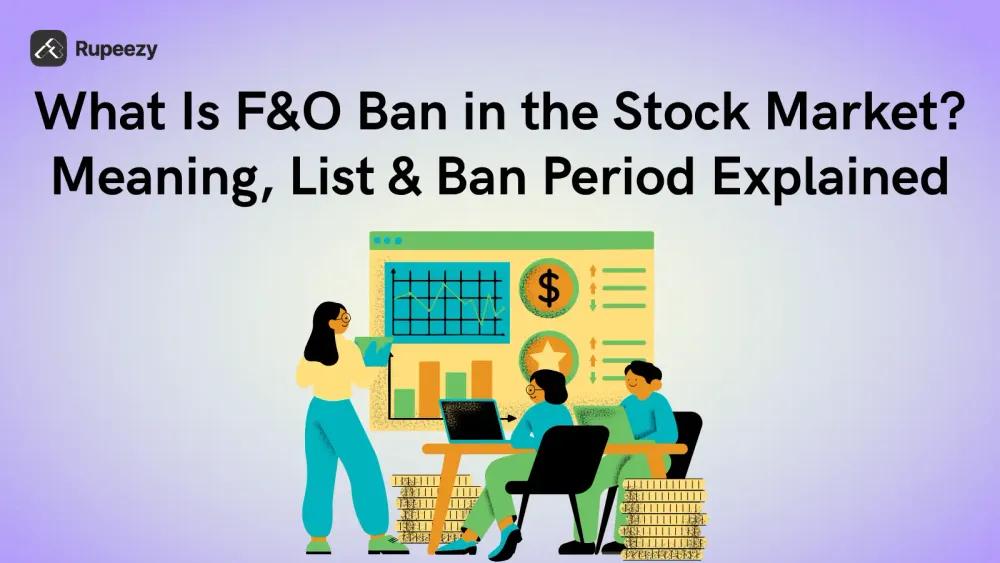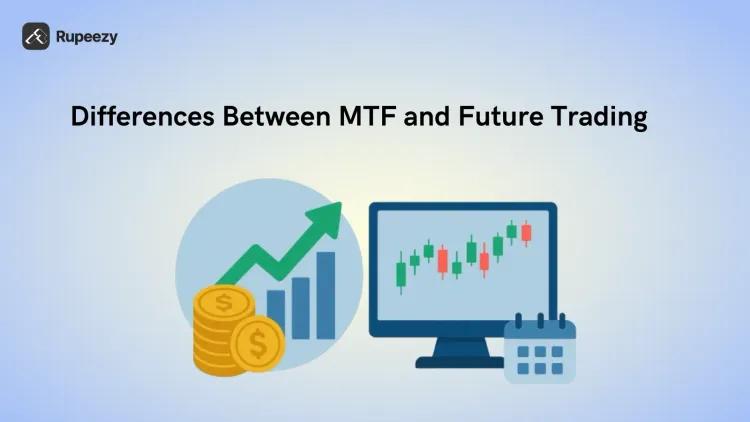What Is F&O Ban in the Stock Market? Meaning, List & Ban Period Explained


00:00 / 00:00
Investing in the share market starts with a deep analysis and understanding of the triggers. But when you trade in the futures and options, the list just increases multifold. While it also offers you an option to earn more, there are certain things that, when not taken into consideration, might impact your trades.
One such term that you must be aware of is F&O ban. You must have come across statements like, “XYZ stock under F&O ban.” Well, this basically means that certain regulatory measures are in place that are now controlling excessive speculation to ensure market stability.
But the biggest question here is why this occurs, and why you should know this? Well, if you are new to trading or one with years of experience, this is really important to keep in mind. So, read this guide to know all the details you need.
What Is F&O Ban?
The F&O ban refers to the Futures and Options ban. It is a temporary restriction placed by different stock exchanges such as NSE and BSE. This is placed on certain securities traded in the derivatives segment.
The main reason behind this ban is linked to the market-wide position limit (MWPL). So, when a stock exceeds 95% of the limit which is set by the exchange, this ban is implemented.
When this limit is crossed, the stock is moved to the F&O ban list. Here, the traders are not allowed to take any new positions in their futures or options contracts. Only square-off trades are permitted. This will stay in place until the open interest reduces below 80% of the MWPL.
The main reasons for this ban is:
Avoid excessive speculations
Bring back market stability
Implementing the F&O ban ensures that there is no single stock in the market that is traded heavily while the rest are not focused. This ensures there is a proper balance in the market.
Latest F&O ban List (16 Oct 2025)
Now, as per the current F&O ban dated 16 Oct 2025, only one is under the list, which is SAMMAANCAP. This list might change on a daily or weekly basis, so keeping an eye on the same becomes really important
Before we dig in deep about the impacts and benefits of the F&O ban, let us understand what MWPL is.
What is Market-Wide Position Limit (MWPL)?
The Market-Wide Position Limit (MWPL) defines the total number of open futures and options contracts. This is the total number that the traders are holding together in a particular stock. By setting this limit, the authorities can ensure that there is a balance and no one stock is excessively traded as compared to the rest.
When the MWPL is decided, two main factors are taken into consideration:
Average Trading Volume: The typical number of shares traded daily in the last month.
Free-Float Shares: Around 20% of the shares available for public trading (excluding promoters).
Now, both of these values are taken into consideration. So, the one that is lower turns into MWPL. This helps in ensuring that there is healthy and transparent trading in the derivatives market.
Example of F&O Ban
Let’s take a simple example to understand the F&O ban better. Now, say that there is a company ABC Ltd.
It has an MWPL of 12,000 contracts. As traders open more futures and options positions, the total open interest rises. Now, 95% of the total trades are 11,400 contracts. So, when the stock reaches this limit, it will enter the F&O ban list.
Once the ban is active, traders cannot take new positions. Only existing ones can be squared off. This restriction will be there until the open interest rate reaches the limit of 80% of the MWPL.
By putting this in place, the chances of having fair trades increase.
Reasons for F&O Ban
There are several reasons why stocks and shares may enter the F&O ban period. The most common reasons this happens are as follows:
1. Excessive Speculation
When there are many traders who are taking the leveraged position, the stock will enter the ban position. This can increase the market position and often lead to a sharp position. This can end with unpredictable price movements.
2. Market Stability
The ban acts as a safeguard. It helps to prevent sudden volatility. By doing so, it can ensure there is smooth functioning in the derivatives market, and traders can benefit from the same.
3. Regulatory Compliance
Stock exchanges like NSE or BSE can impose the F&O ban as compliance. It is mainly to ensure that the trading volumes are within the limits set by the MWPL. This helps in keeping overall market exposure in check.
4. Fair Price Discovery
The stock market also works on the demand and supply rules. So, when there is a limit on the excessive derivatives activity with the help of the ban, the prices reflected are actual. There is no unwanted increase or decrease that is not beneficial for traders.
5. Investor Protection
The F&O ban protects traders, especially retail investors. Since this helps in avoiding the unwanted speculations and hikes, the chances of losses are reduced to a great extent, which is quite helpful.
Penalties for Violating the F&O Ban
Breaking the F&O ban rules can attract strict penalties. These are implied by the stock exchange. If a trader opens new positions in a stock that is under a ban, a penalty of 1% of the value of the increased position is imposed. The fine is limited to Rs. 5,000 per transaction and capped at Rs. 1 lakh in total.
These penalties ensure that there is no misuse of the system and all the traders, even the small ones, gain from fair trades. This helps to bring in transparency and stability in the derivatives market.
Exception to the F&O Ban
The F&O ban applies only to individual stocks. It cannot be applied to the index derivatives such as Nifty or Bank Nifty. Index-based contracts represent the broader market. Hence, these are not affected by excessive trading in one company.
So, when you consider the index F&O, the MWPL is not valid. This means that even when there is a ban period, the index trading will stay unaffected, ensuring trades go on smoothly.
Monitoring F&O Ban Alerts
It is not easy for traders to know when a ban is imposed and when it is lifted. Hence, the stock exchanges issue timely alerts. This helps traders to keep track when the stock is quite close to the MWPL limit. So, say that there is a stock that reaches the open interest limit of around 60% of MWPL. Now, here the NSE will trigger a signal to the traders that this is nearing the ban. This alert is visible on the trading platforms and will allow the traders to act on time.
Monitoring these alerts is crucial for managing open positions and avoiding unnecessary penalties. Staying updated with exchange notifications will help you ensure that the trade is regulated well.
Impact of F&O Ban on Traders
The F&O ban has a direct effect on traders’ strategies. It impacts liquidity and portfolio management. This impacts the traders quite prominently in the following manner:
1. Restricted Trading Opportunities
When there is a ban, the traders cannot take any new position. They can only square off the existing positions. This limits the chances of volatile and excessive price changes, which can impact profitability.
2. Reduced Liquidity
When there is a ban, the participation in the trades also drops. This leads to a decline in the volume, which can increase the bid-ask spread. This makes it quite hard for the traders to complete trades properly.
3. Price Volatility
Since there is a change in the positions very quickly, there will be high volatility in the market. These fluctuations will rebalance the prices, and at times, your overall trades will be impacted.
4. Higher Margin Requirements
Brokers may demand higher margins on banned stocks. This is mainly due to the rise in perception and the risks associated. You would need to add your cash flow, and the capital would be needed more.
5. Portfolio Adjustments
Traders often shift their focus to other active stocks or index derivatives. This is mainly to avoid any kind of disruption. It will ensure that there are smooth trades, but at the same time, there will be high portfolio rebalancing. This is necessary to stay positive.
What Should You Do During an F&O Ban
When a stock enters the F&O ban list, you need to act in a proper and planned manner. Acting based on emotions can be really harmful and can impact your trades badly. So, here is what you would need to do.
1. Avoid Taking New Positions
Do not start any new trade when there is a ban. Instead, focus on the positions that you have right now. Taking new positions during the ban can lead to penalties and compliance issues with your broker or exchange.
2. Focus on Squaring Off Existing Trades
Use this period to close or reduce open positions. And when you see that there is a drop in open interest rates, you can evaluate the prices and enter new trades if needed.
3. Monitor Exchange Alerts Regularly
Stay updated with NSE or BSE notifications. Any alert you get is an important reminder that you need to work on the trades that you have. So be very cautious and stay vigilant.
4. Diversify Your Trades
Shift your focus to the index and diversify your portfolio. This will help you to stay in a better position and ensure you make profits.
5. Review Your Risk Exposure
Take this opportunity to assess your overall portfolio risk. Ensure there is no portfolio overlap or any position that is bringing you down. This can be really helpful
Conclusion
The F&O ban is designed to maintain discipline and protect traders. It helps to avoid the risks associated with excessive speculation in the derivatives market. It helps stabilize prices and boost fair participation. This is why you need to stay agile and follow the MWPL alerts well.
This is helpful in the process of diversification as well. But to have proper ideas and processes, you need the support of experts as well.
This is where you can connect with Rupeezy. Track the F&O ban list and ensure that your trades stay effective. Make the decision based on the information and facts, and stay ahead.
FAQs
What happens when a stock is under F&O ban?
When a stock enters the F&O ban, traders cannot take new positions. Only closing or reducing existing positions is allowed until open interest falls below the permitted level.
How long does an F&O ban remain active?
The ban continues until the stock’s total open interest drops below 80% of its Market-Wide Position Limit (MWPL).
Can I trade in the cash market during an F&O ban?
Yes, the restriction applies only to derivatives. You can freely buy or sell the stock in the cash market segment.
Does an F&O ban impact stock prices?
Yes. When there is an F&O ban, you can find short-term volatility that can impact your position. But this is short and will fade when the ban is lifted.
How can traders stay informed about F&O bans?
You can check the daily F&O ban list on the NSE or BSE website or use platforms like Rupeezy for instant market updates and alerts.
The content on this blog is for educational purposes only and should not be considered investment advice. While we strive for accuracy, some information may contain errors or delays in updates.
Mentions of stocks or investment products are solely for informational purposes and do not constitute recommendations. Investors should conduct their own research before making any decisions.
Investing in financial markets are subject to market risks, and past performance does not guarantee future results. It is advisable to consult a qualified financial professional, review official documents, and verify information independently before making investment decisions.

All Category










